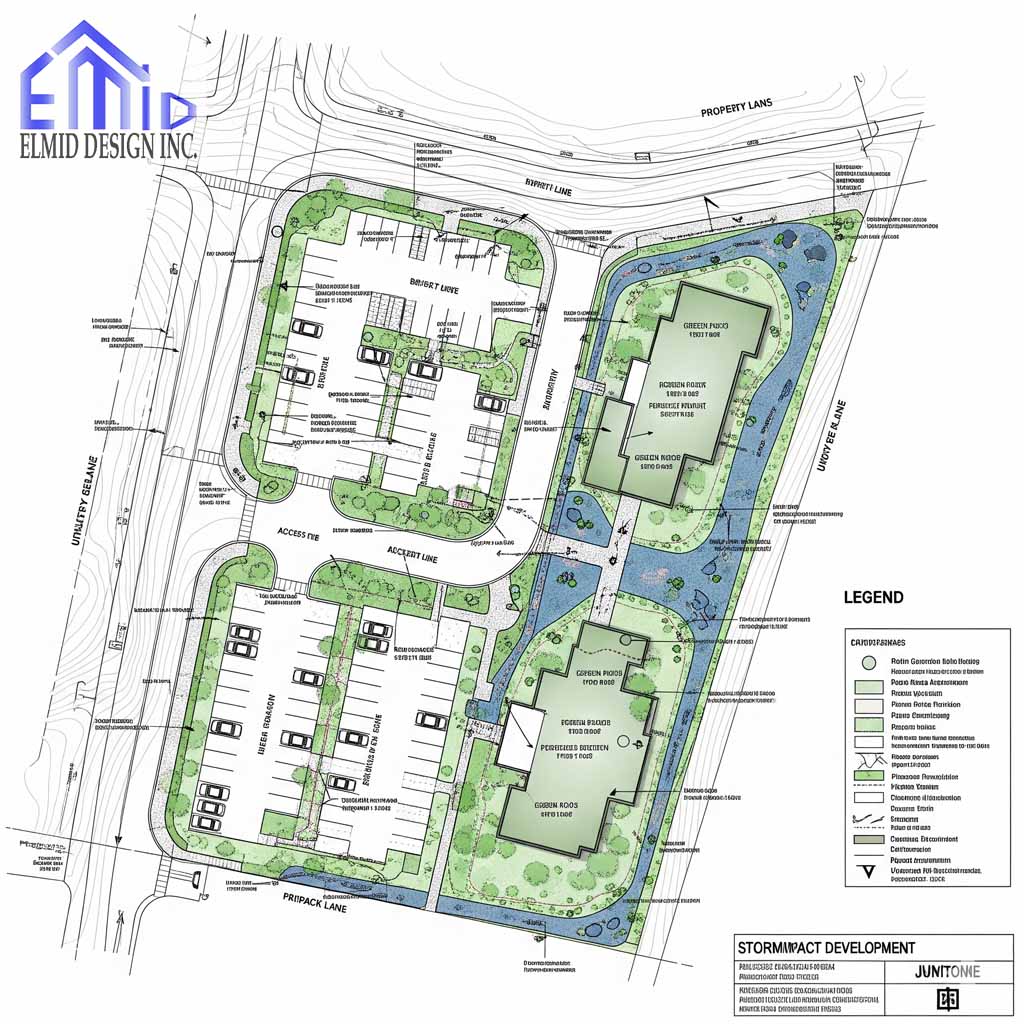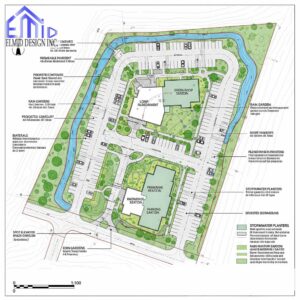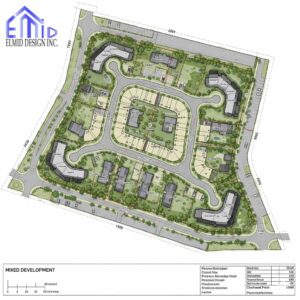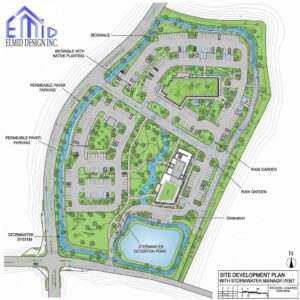Stormwater management Brampton is more important than ever as the city faces increasing urban development and changing climate patterns. With thousands of homes, roads, and commercial areas built across a growing population base, managing rainfall and runoff safely has become a top priority. Brampton has adopted a forward-thinking strategy that combines strong infrastructure, sustainable retrofits, and modern funding to handle this critical challenge. From the stormwater charge system to community-led green projects, the city is building solutions that protect both the environment and public safety. This article explores how Brampton manages its stormwater system, why it matters, and what the city is doing to prepare for the future.
Overview of Brampton’s Stormwater Infrastructure
Brampton’s stormwater system includes over 1400 kilometers of storm sewers and more than 180 engineered stormwater ponds. These pipes and ponds form an underground and surface-level network that manages runoff from roads, rooftops, and paved areas. During rain and snowmelt, water travels through drains and is either stored or released gradually into creeks and rivers. This process reduces the risk of flooding while also protecting water quality. As a result, the system acts as a silent shield against property damage and erosion. Its size and complexity show how essential stormwater management is for a growing city like Brampton.
Understanding the Stormwater Charge in Brampton
To maintain and expand its stormwater network, Brampton introduced a stormwater charge in 2020. This funding model is based on the amount of hard surface area on each property, such as driveways and rooftops. Since hard surfaces don’t absorb water, they generate runoff that must be managed by the city. The charge appears on the water bill, allowing for steady investment in the system. It also ensures that property owners contribute fairly based on how much runoff they produce. This approach has replaced unpredictable funding methods and made infrastructure planning more reliable.
Low-Impact Development for Smarter Growth
Brampton integrates low-impact development into its stormwater strategy to reduce reliance on traditional pipes and ponds. Low-impact development refers to planning that uses natural processes to slow down and absorb water close to where it falls. Rain gardens, bioswales, permeable pavement, and green roofs all serve this purpose. They not only reduce runoff but also improve soil health and filter pollutants. In neighborhoods across the city, new developments are encouraged to include these features. As the city becomes denser, these low-tech, high-impact tools play a key role in preventing costly water issues.
Fletcher’s Creek SNAP: A Green Retrofit Model
The Sustainable Neighbourhood Action Plan in the Fletcher’s Creek area is one of Brampton’s most successful stormwater initiatives. This pilot program introduced rain gardens and bioretention zones near schools and along streets. These features absorb runoff while enhancing the look and function of public spaces. Schoolyards and sidewalks were transformed into sponge-like systems that manage water on site. The project reduced local flooding risks and improved environmental conditions without disrupting the community. As a result, it became a model for future retrofits in older areas where upgrading pipes is too expensive or invasive.
County Court SNAP and Filter Swale Innovation
In another area of the city, Brampton applied green stormwater design during a road reconstruction project. The County Court SNAP introduced filter swales alongside streets and parking areas. These shallow, vegetated channels guide water through natural soil systems, allowing it to filter slowly before entering the drainage network. Instead of building new underground pipes, engineers used landscape-based features that deliver both function and aesthetics. This design supports long-term water quality goals while cutting down on installation and maintenance costs. It demonstrates how infrastructure and ecology can work together in urban settings.
Stormwater Upgrades Along Etobicoke Creek
Etobicoke Creek is one of Brampton’s key watersheds and has seen major stormwater improvements in recent years. The city, with support from the province, invested in a 600-meter stormwater system upgrade along the downtown corridor. These changes improved the area’s capacity to handle extreme rainfall and reduced flooding risks for nearby properties. At the same time, the work supported goals tied to habitat restoration and sustainable development. Since the creek passes through dense urban and natural zones, the project required careful planning. It now stands as a strong example of integrated infrastructure investment.
Catch Basin Inserts: Simple Tech, Big Impact
To improve water quality at the source, Brampton has tested new technologies such as catch basin inserts. These devices fit inside existing drains and trap garbage, oils, and other pollutants before they enter the storm system. Products like EnviroPod and LittaTrap were installed at city maintenance yards as part of pilot programs. During monitoring, they showed strong results in reducing pollution from snowmelt and rainfall. Because the technology is easy to install and doesn’t require major construction, it offers a cost-effective way to enhance the city’s existing drainage network. This innovation highlights Brampton’s practical approach to cleaner water.
Green Infrastructure as Functional Landscape
In Brampton, green infrastructure isn’t just an environmental bonus—it’s part of the city’s stormwater toolbox. Landscape elements like swales, gardens, and tree trenches help slow water flow and remove contaminants before they reach sewers or streams. These systems also add value by improving street design, increasing shade, and boosting community aesthetics. Brampton’s planners use green infrastructure in public parks, road edges, and even commercial zones. By layering stormwater solutions into urban design, the city reduces strain on its sewer network and enhances livability for residents. This method creates multi-purpose spaces that benefit everyone.
Connecting Funding, Design, and Performance
Brampton’s stormwater management isn’t just about engineering—it’s also about connecting funding with long-term performance. The stormwater charge funds maintenance, retrofits, and monitoring so that the city can track results and make data-driven decisions. This model avoids short-term fixes and instead supports durable improvements. Through community engagement, developers and homeowners understand how their land impacts runoff. That awareness strengthens support for long-term investment. As Brampton continues to grow, its system remains adaptable. Ongoing evaluation ensures that every dollar spent translates into measurable outcomes that benefit the entire city.

Policy and Regulatory Framework in Brampton
Stormwater management Brampton operates within a clearly defined regulatory framework guided by municipal, regional, and provincial standards. The City of Brampton sets performance-based stormwater design standards enforced through its development approval process. In addition, the Region of Peel and conservation authorities such as Credit Valley Conservation support this framework with watershed-specific guidance. Together, these agencies review designs, monitor construction, and enforce compliance with runoff control and water quality objectives. This multi-tiered system ensures that all infrastructure built within Brampton aligns with environmental goals. Regulatory oversight adds a layer of accountability that protects both natural and built environments.
Watershed Planning for Resilient Infrastructure
Brampton uses watershed-based planning to design stormwater infrastructure that responds to local conditions. Each watershed, like Fletcher’s Creek or Etobicoke Creek, presents different topography, soil types, and drainage patterns. Therefore, the city adjusts its stormwater strategies based on those characteristics. The SNAP program is one example of this tailored approach. By involving local stakeholders and conservation experts, Brampton designs solutions that reflect community needs and environmental realities. This strategy avoids applying a one-size-fits-all method across the city. Instead, it delivers higher performance by matching infrastructure to the landscape it serves.
Monitoring and Long-Term System Performance
Monitoring forms a crucial part of stormwater management Brampton. The city regularly inspects ponds, swales, catch basins, and green infrastructure to measure performance. These inspections help identify needed repairs and track how systems respond during storms. Moreover, stormwater charge revenues fund data collection and system upgrades. That financial structure allows for proactive maintenance instead of waiting for failure. Brampton also pilots new technologies such as catch basin inserts and tracks their effectiveness. Through detailed reporting and performance benchmarks, the city maintains accountability. This data-driven approach ensures long-term system reliability across a growing urban landscape.
Designing for a Changing Climate
Stormwater design in Brampton increasingly incorporates climate projections. Traditional engineering standards based on historical rainfall are no longer sufficient. Today, engineers consider future storm intensities using climate models and rainfall simulations. These inform pipe sizing, storage volume, and emergency overflow planning. The city also evaluates flood risk using digital terrain mapping and predictive analytics. This forward-thinking method helps reduce future damage from extreme weather events. In addition, Brampton applies these models to retrofit plans and new development approvals. Designing for tomorrow’s climate today gives the city an edge in managing growing stormwater challenges.
Collaborative Stormwater Solutions
Brampton’s approach to stormwater management emphasizes collaboration across public and private sectors. The city works closely with developers, engineering firms, and conservation authorities to design and deliver infrastructure projects. These partnerships allow Brampton to integrate green infrastructure into new subdivisions and retrofit aging areas more effectively. The SNAP program is a strong example where community groups, schools, and municipal planners co-created sustainable drainage features. When diverse stakeholders contribute, projects benefit from shared knowledge and stronger outcomes. Collaboration also speeds up innovation by allowing different disciplines to test and improve design ideas in the field.
Benefits of Green Infrastructure Integration
Incorporating green infrastructure into stormwater planning offers Brampton multiple benefits. Features like bioswales, rain gardens, and permeable pavement enhance drainage while filtering out contaminants. These systems also help recharge groundwater and reduce the volume of runoff entering pipes and creeks. As a result, they lower the chance of flooding and cut long-term maintenance costs. In public areas, green infrastructure improves aesthetics and creates natural cooling zones. The city uses this approach to build more livable neighborhoods while strengthening its stormwater system. This balance between function and form improves urban resilience and environmental quality.
Engineering Expertise in Stormwater Projects
Successful stormwater management in Brampton depends on sound engineering. Companies like Elmid Design Inc play a central role in bringing complex projects to life. As a firm licensed by Professional Engineers Ontario, Elmid Design Inc provides certified design, modeling, and compliance services for stormwater systems. Their work ensures that public and private projects meet regulatory standards and environmental performance goals. Whether working on new subdivisions or upgrading older neighborhoods, engineers bring data, precision, and accountability to the process. Brampton’s reliance on qualified firms reflects its commitment to safe and sustainable infrastructure development.
Preparing for Citywide Expansion and Growth
As Brampton continues to expand, the demands on its stormwater system will grow. New developments must include infrastructure that handles more intense storms and greater impervious surface areas. To meet this challenge, the city plans to expand programs like SNAP, increase green infrastructure coverage, and adopt more real-time monitoring technologies. In addition, Brampton is updating its stormwater design standards to reflect climate science and modern land use. By doing so, the city positions itself for long-term sustainability. Stormwater management Brampton is not only about today’s needs but also about preparing for a more unpredictable future.
Routine Inspection and Seasonal Maintenance Practices
Stormwater infrastructure in Brampton requires routine inspections and consistent seasonal maintenance to remain effective. During spring and fall, crews inspect catch basins, clean debris from inlets, and remove sediment from stormwater ponds. This regular activity prevents blockages that could lead to flooding during rainstorms. In addition, vegetation surrounding green infrastructure such as bioswales and rain gardens must be trimmed and maintained. These inspections also reveal structural damage or erosion that could compromise system performance. Because Brampton experiences a wide range of seasonal weather conditions, this maintenance ensures resilience against both snowmelt and heavy rainfall events throughout the year.
Stormwater Credit Program and Property Incentives
Brampton encourages property owners to manage runoff responsibly by offering a stormwater credit program. This initiative provides financial incentives to those who install approved features like permeable pavement, green roofs, or rainwater harvesting systems. Property assessments determine the amount of impervious surface reduced through on-site solutions. As a result, eligible owners can receive a reduction in their stormwater charge. This program helps shift some of the responsibility for stormwater away from municipal systems and empowers individuals and businesses to play a direct role in water management. It also fosters broader awareness about sustainable practices across the city.
The Role of Homeowners in Managing Runoff
Residential areas contribute significantly to urban runoff, which is why homeowner participation is essential in stormwater management Brampton. Simple changes like disconnecting downspouts, building rain gardens, or using rain barrels can reduce pressure on public infrastructure. These actions slow water down and allow it to soak into the ground rather than rush into storm drains. In older neighborhoods, retrofitting properties with modern drainage techniques can also prevent local flooding. Education and outreach programs from the city help inform residents about these techniques. When homeowners contribute to managing runoff, it creates a citywide impact on stormwater performance.
Case Study Reflections from Community Retrofits
Brampton’s community retrofit projects have demonstrated that stormwater management can succeed through partnerships and design innovation. In areas like Fletcher’s Creek and County Court, public land was transformed using green infrastructure without major disruptions. Local schools hosted rain garden installations while neighborhood streets received bioswales and filter swales. These changes improved drainage, boosted curb appeal, and engaged the public in environmental stewardship. They also allowed engineers to test designs under real conditions and make improvements for future projects. Because these case studies were well documented, they continue to guide similar programs throughout Brampton today.
Data-Driven Planning and System Adaptability
Brampton uses data to inform every major decision about its stormwater system. Performance data from inspections, rainfall records, and modeling tools guide where upgrades should occur. Mapping software helps visualize flood-prone areas and prioritize neighborhoods for retrofits. Additionally, climate projections inform how future systems are designed and how much capacity must be built. This evidence-based planning approach prevents waste and improves long-term resilience. Because Brampton continues to grow, adaptability is built into every design standard. The city uses its data not only to manage existing problems but also to prevent new ones from emerging.
Public Education and Long-Term Engagement
Public education is a core part of Brampton’s stormwater strategy. Residents need to understand how their everyday choices influence runoff, pollution, and flood risk. Through workshops, school programs, and online tools, the city builds awareness around issues like lawn maintenance, driveway runoff, and illegal dumping. Education helps create a shared responsibility between the city and its citizens. Informed communities are more likely to support infrastructure investments and adopt green practices. Over time, this leads to a culture of stewardship where residents take active roles in preserving water quality and reducing flood hazards in their own neighborhoods.
Planning for the Next Phase of Stormwater Strategy
Brampton continues to look forward by refining its stormwater management strategies. Current plans include expanding the SNAP program into new neighborhoods and integrating more green infrastructure into private developments. The city is also exploring emerging technologies that allow real-time monitoring of water flow, blockage detection, and performance reporting. In addition, design standards are being reviewed to better match future climate projections and regional growth. By aligning stormwater planning with housing development and environmental restoration, Brampton builds a stronger, safer city. These next steps reflect the city’s commitment to long-term sustainability and risk reduction.
FAQs
What is the stormwater credit program?
It offers eligible property owners a discount on their stormwater charge if they install approved runoff control measures.
How often is Brampton’s stormwater system inspected?
City crews inspect and maintain stormwater infrastructure regularly, especially before and after seasonal weather shifts.
Can homeowners help manage stormwater?
Yes, residents can use rain barrels, plant rain gardens, and disconnect downspouts to reduce runoff from their property.
Why are retrofit projects important?
They allow the city to upgrade older infrastructure using modern techniques without the cost of full system replacement.
How does Brampton use data in planning?
The city collects performance, rainfall, and mapping data to prioritize upgrades and design climate-ready infrastructure.

Elmid Design Inc: Expert Stormwater Engineering in Brampton
Elmid Design Inc is a licensed engineering firm with a Certificate of Authorization from Professional Engineers Ontario, offering advanced stormwater solutions across Brampton. The firm specializes in drainage system design, green infrastructure integration, and regulatory compliance for both public and private developments. With a proven record of delivering durable, efficient systems, Elmid Design Inc supports projects that meet today’s environmental and planning standards. Their technical expertise ensures that infrastructure remains resilient, sustainable, and fully aligned with Brampton’s stormwater management goals.
Geographic Locations That We Service:
Our Licensed Professional Engineers specializing in Engineered Site Grading Plans offer the best-engineered site grading plan, lot grading and erosion plan, and drainage plan to obtain site plan approval and building permits in Ontario, including a wide range of municipalities. Each area boasts unique features and requirements, making our tailored approach essential for success.
Toronto and Surrounding Areas
In the vibrant heart of Ontario, we service Toronto (City of Toronto) and surrounding areas. Additionally, we cover Oshawa (City of Oshawa), Pickering (City of Pickering), and Clarington (Municipality of Clarington). Furthermore, our expertise extends to Ajax (Town of Ajax), Whitby (Town of Whitby), Brock (Township of Brock), Scugog (Township of Scugog), and Uxbridge (Township of Uxbridge).
Halton Region
Moving to the Halton Region, our services encompass Burlington (City of Burlington) and Halton Hills (Town of Halton Hills). Also included are Milton (Town of Milton) and Oakville (Town of Oakville).
Peel Region
In the Peel Region, we provide services in Brampton (City of Brampton), Mississauga (City of Mississauga), and Caledon (Town of Caledon).
York Region
Our services in the York Region cover Vaughan (City of Vaughan), Aurora (Town of Aurora), and East Gwillimbury (Town of East Gwillimbury). We also cater to Georgina (Town of Georgina), Markham (City of Markham), Newmarket (Town of Newmarket), Richmond Hill (City of Richmond Hill), Whitchurch-Stouffville (Town of Whitchurch-Stouffville), King (Township of King), and Bradford-West Gwillimbury (Town of Bradford-West Gwillimbury). Each municipality here offers a distinct setting, requiring our specialized approach.
Other Southern Ontario Cities and Towns
We also serve many other cities and towns in Southern Ontario. These include Hamilton (City of Hamilton), St. Catharines (City of St. Catharines), Niagara on the Lake (Town of Niagara on the Lake), Brant (County of Brant), Cambridge (City of Cambridge), Kitchener (City of Kitchener), Waterloo (City of Waterloo), and Woodstock (City of Woodstock). Furthermore, we operate in Guelph (City of Guelph), Centre Wellington (Township of Centre Wellington), Shelburne (Town of Shelburne), Orangeville (Town of Orangeville), New Tecumseth (Town of New Tecumseth), Essa (Town of Essa), Collingwood (Town of Collingwood), Wasaga Beach (Town of Wasaga Beach), Barrie (City of Barrie), Midland (Town of Midland), Orillia (City of Orillia), Ramara (Town of Ramara), Minden Hills (Town of Minden Hills), North Kawartha (Town of North Kawartha), Kawartha Lakes (City of Kawartha Lakes), Peterborough (City of Peterborough), Selwyn (Town of Selwyn), and Brighton (Municipality of Brighton).




